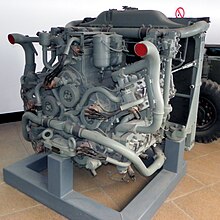Reciprocating internal combustion engine
| Chrysler A57 Multibank | |
|---|---|
 | |
| Overview | |
| Manufacturer | Chrysler |
| Layout | |
| Configuration | Multibank (5-bank W30) |
| Displacement | 1,253 cu in (20.5 L) |
| Cylinder bore | 3.4375 in (87 mm) |
| Piston stroke | 4.5 in (114 mm) |
| Compression ratio | 6.2:1 |
| Combustion | |
| Fuel system | Naturally aspirated, Carter TD-1 carburetors |
| Fuel type | Gasoline |
| Cooling system | Liquid |
| Output | |
| Power output | 370 hp (276 kW) @ 2400 rpm |
The Chrysler A57 Multibank is a 30-cylinder 1,253 cu in (20.5 L) engine that was created in 1941 as America entered World War II. It consists of five banks of inline-6 cylinder engines.
History

It was born out of the necessity for a rear-mounted tank engine to be developed and produced in the shortest time possible for use in the M3A4 Lee medium tank and its successor M4A4 Sherman medium tank. Each had lengthened hulls to accommodate the A57.
In order to use existing tooling, five 250.6 cu in (4.1 L) Chrysler flathead engines (bore 3.4375 in or 87 mm, stroke 4.5 in or 114 mm) were arranged around a central shaft, producing a unique 30-cylinder 21-litre (1,253 cu in) engine in a relatively compact but heavy package.
A total of 109 Lees and 7,499 Shermans were fitted with the A57. The M4A4 was largely supplied to the British, the US preferring the M4A3 with the more conventional Ford GAA V8 engine, and restricting their M4A4s to overseas use.
Design
The combined assembly consisted of five of these straight-six engines mounted in a pseudo-radial fashion upon a central cast-iron crankcase. The arrangement employed a common radiator, water pump, oil pan & dual oil pumps, with each of the five component crankshafts fitted with a geared flywheel that meshed with a central sun gear driving a main shaft running through the central crankcase. Each of the six-cylinder sub-blocks had an iron head and featured a Carter TD-1 carburetor and a 6.2:1 compression ratio, with tuned pipes that fed into a common exhaust; output was 370 hp (280 kW) at 2400 rpm.
This large engine assembly necessitated a longer hull (same as the M4A6), becoming the M4A4; most of these were supplied to Allied countries under Lend-Lease.
In the February 1944 issue of the magazine Popular Science, an advertisement by Chrysler claimed the A57 could still move the tank it was fitted in even if 12 out of its 30 cylinders were knocked out.
Preservation
The engine was preserved at the Walter P. Chrysler Museum in America and at the Imperial War Museum Duxford in the United Kingdom. The Tank Museum in Dorset, England has a complete A57. That museum also acquired a second engine without radiator in 2019, from the UK Defence Academy at Shrivenham. Both are currently in storage in the museum's Conservation Centre.
References
- ^ Berndt, Thomas (1993). Standard Catalog of U.S. Military Vehicles. Krause Publications. p. 193. ISBN 0-87341-223-0.
- Fletcher The Universal Tank, p 70
- ^ "The Chrysler A57 Multibank: The Motor Chrysler Came Up With To Power Tanks, It Was Crazy, And It Worked!". The Sherman Tank Site. Retrieved 30 October 2022.
- Berndt, p.190.
- ^ Berndt, p.192.
- Popular Science. Bonnier Corporation. February 1944.
- "Walter P. Chrysler Museum closing today", Autoblog, 31 December 2012
- John Christopher (2014), Sherman M4 Medium Tank the War Machine, Amberley Publishing Limited, p. 28, ISBN 978-1445638768
- "The Tank Museum". Twitter. 10 July 2018. Retrieved 11 February 2020.
External links
- The Chrysler A57 Multi-Bank Engine - An amazing engine by Julian Edgar of AutoSpeed.